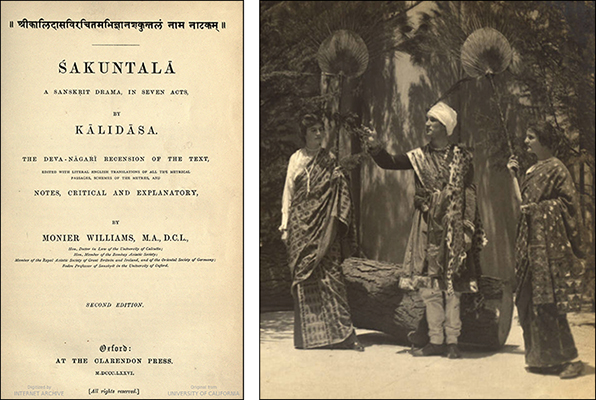23 Sanskrit

There is little doubt that Kālidāsa is one of the most celebrated poets not only in Sanskrit literature but in all of South Asian history. His works represent the acme of Sanskrit poetry and became the model for subsequent poets in Sanskrit as well as most of the major languages of the region. Despite his celebrity and the reverence for his works, very little is definitively known about Kālidāsa. Based on tradition and meagre references to his own life in his works, most scholars agree that he lived in early 5th century CE in the city of Ujjain, located roughly at the center of the Indian peninsula.
Abhijnanasakuntala (The Recognition of Shakuntala), is based on an episode taken from the great Indian epic, the Mahabharata. Kālidāsa retains the basic plot line of the episode but alters it in key ways to adapt it to the stage and make it more romantic. The story revolves around a beautiful maiden named Shakuntala who is the daughter of an ascetic sage and a heavenly nymph. Abandoned by her parents, she was raised in the hermitage of another sage who found her in the care of a flock of “shakunta” birds. Hence, he named her Shakuntala, i.e., protected by shakunta birds. One day, she falls in love with a visiting king named Dushyant who gives her a ring as the token of their love and promises to return to take her with him. In his absence Shakuntala gives birth to a son. Due to a curse, he forgets about her and only recalls her when he encounters the ring again after many years. Their son, Bharata, goes on to become the first emperor of India whose descendants are the protagonists of the Mahabharata.
Of all his works, Kālidāsa’s Abhijnanasakuntala became the most world-renowned after it was translated into English by Sir William Jones in Calcutta in 1789. Translations in German and French appeared subsequently. The play was to be translated into all these languages, and many more, numerous times by prominent linguists and indologists of the 19th and 20th centuries. Among these is the translation featured here by the famous indologist Sir Monier Monier-Williams.
Scholarly interest in Sanskrit in European and American academia is not only due to the language’s own rich literary tradition but also because it is the sacred language of the Hindu, Buddhist and Jain religious traditions. Even though the Buddhist and Jain traditions initially used other languages they eventually switched to Sanskrit, as it was the language of high culture, philosophy, and scholarly discourse in ancient India. The linguistic influence of Sanskrit on local South Asian languages is comparable to Latin and ancient Greek in Europe.
Vedic Sanskrit, an ancient form of Sanskrit in which the Vedas, the most ancient Hindu scriptures, are composed, is an important source for the study of the evolution of Indo-European languages. In fact, having been orally composed between 1500 and 1200 BCE, the Vedas are among the oldest literary creations in any Indo-European language.
The study and teaching of Sanskrit at UC Berkeley goes back to the 1890s and includes an impressive list of world renowned scholars and interest in Kālidāsa has also been keenly pursued here. Among others, Professor Arthur W. Ryder, Professor of Sanskrit, published a translation of a selection of Kālidāsa’s works in 1912 that included Abhijñānaśākuntala. This translation became the basis for a performance of the play in the Greek Theater in 1914. The play continues to be widely performed into the present day. Today, Professor Robert P. Goldman is UC Berkeley’s Magistretti Distinguished Professor of Sanskrit. He is also the director, general editor, and principal translator of the recently published multi-volume critical edition of a fully annotated English translation of Valmiki’s famous epic, Ramayana, and has received many awards and fellowships.
Contribution by Adnan Malik
Curator and Cataloger for the South Asia Collection
South/Southeast Asia Library
Special thanks to Sally Sutherland Goldman, Senior Lecturer in Sanskrit
Department of South and Southeast Asian Studies
Authors: Kālidāsa
Imprint: Oxford : Clarendon Press, 1876.
Edition: 2nd
Language: Sanskrit
Language Family: Indo-European, Indo-Aryan
Source: HathiTrust Digital Library (UC Berkeley)
URL: https://catalog.hathitrust.org/Record/002751897
Other online editions:
- Translations of Shakuntala and Other Works by Kālidāsa (Internet Archive)
- Monier-Williams translation and Sanskrit text (2nd ed.) (Internet Archive)
Select Print editions at Berkeley:
- Śakuntalā, a Sanskrit drama, in seven acts. The Deva-Nāgari recension of the text, ed. Oxford : Clarendon Press, 1876.

